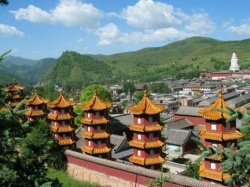Difference between revisions of "Wu-t'ai, Mount"
| Line 1: | Line 1: | ||
[[File:Wutai_mountain.jpg|thumb|250px|]] | [[File:Wutai_mountain.jpg|thumb|250px|]] | ||
<poem> | <poem> | ||
| + | |||
| + | |||
| + | |||
| + | |||
| + | |||
| + | |||
| + | |||
| + | |||
'''[[Wu-t'ai]], Mount''' | '''[[Wu-t'ai]], Mount''' | ||
[[五台山]] (PY [[Wutai]]; Jpn [[Godai-san]]) | [[五台山]] (PY [[Wutai]]; Jpn [[Godai-san]]) | ||
Latest revision as of 13:34, 26 December 2023
Wu-t'ai, Mount
五台山 (PY Wutai; Jpn Godai-san)
Also known as Mount Ch'ing-liang. A mountain located in the Wu-t'ai mountain range in Shansi Province in China.
This mountain has long been identified with Mount Clear and Cool (Ch'ing-liang) where, according to the Flower Garland Sutra, Bodhisattva Manjushri dwells.
It was counted as foremost of the four sacred mountains related to Buddhism in China, the other three being:
Mount P'u-t'o, which is associated with Bodhisattva Perceiver of the World's Sounds;
Mount Chiu-hua, with Bodhisattva Earth Repository; and
Mount E-mei, with Bodhisattva Universal Worthy.
Mount Wu-t'ai prospered as a center of Chinese Buddhism where eminent priests from throughout the country as well as from Central Asia, Korea, and Japan studied, practiced, and lectured.
In 766 Pu-k'ung and Han-kuang made it a center of Esoteric Buddhism, building two temples there.
In 770 Fa-chao, a noted priest of the Pure Land teachings, engaged there in the practice of reciting the name of Amida Buddha.
Ch'eng-kuan (738-839), the fourth patriarch of the Flower Garland school (Hua-yen), stayed at Ta-hua-yen-ssu temple on Mount Wu-tai and lectured on the Flower Garland Sutra.
The mountain was a center of the Flower Garland school and also a center of the Chinese Zen (Ch'an) school.
Among the Japanese priests who made a pilgrimage there were Gembo(d. 746), Jikaku (794-864), Chonen (d. 1016), and Jojin (1011-1081).
Over the centuries, more than one hundred temples are said to have been built on the flat summit of this mountain. Beginning in the Yuan dynasty (1271-1368), lamaseries, or temples of Tibetan Buddhism, were also built there.
